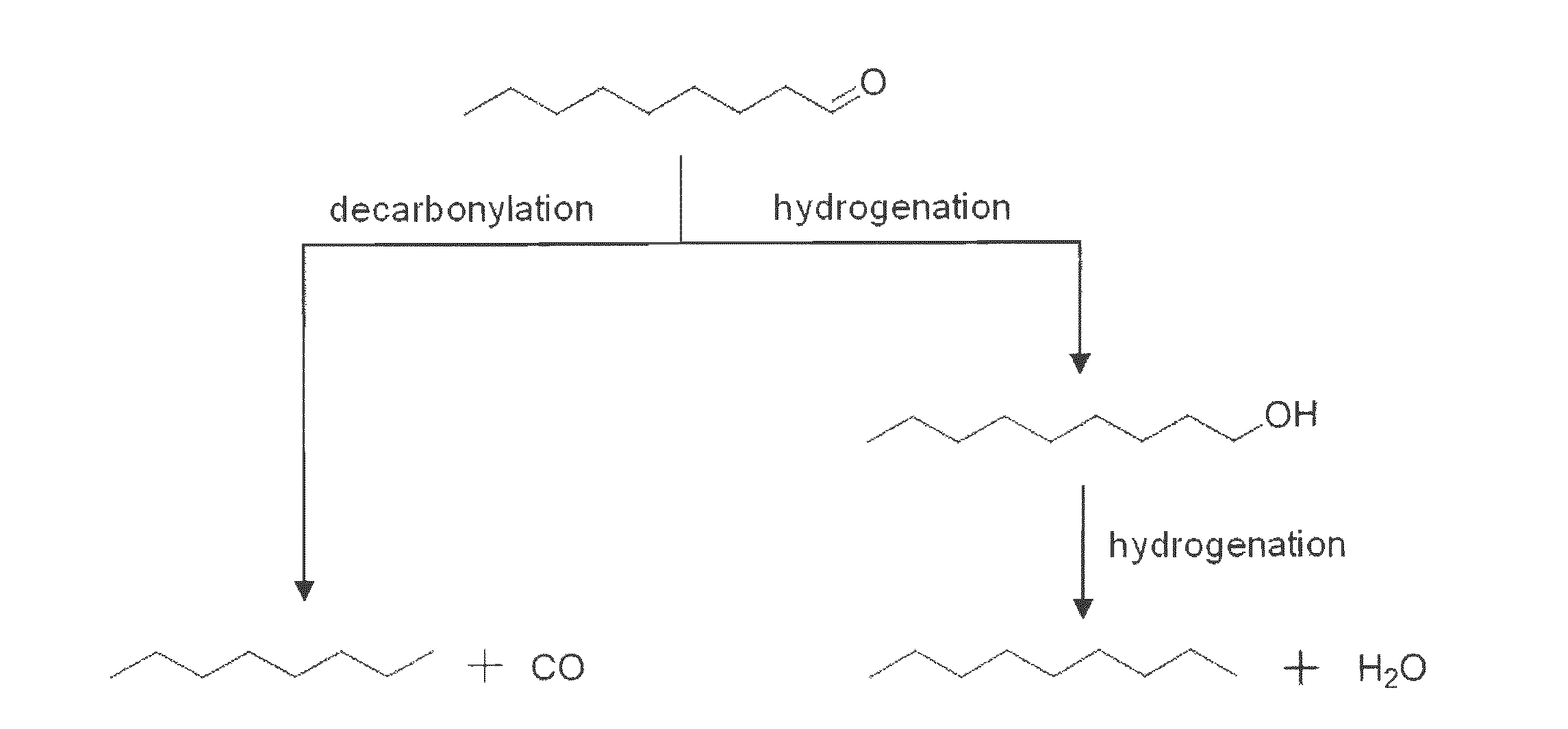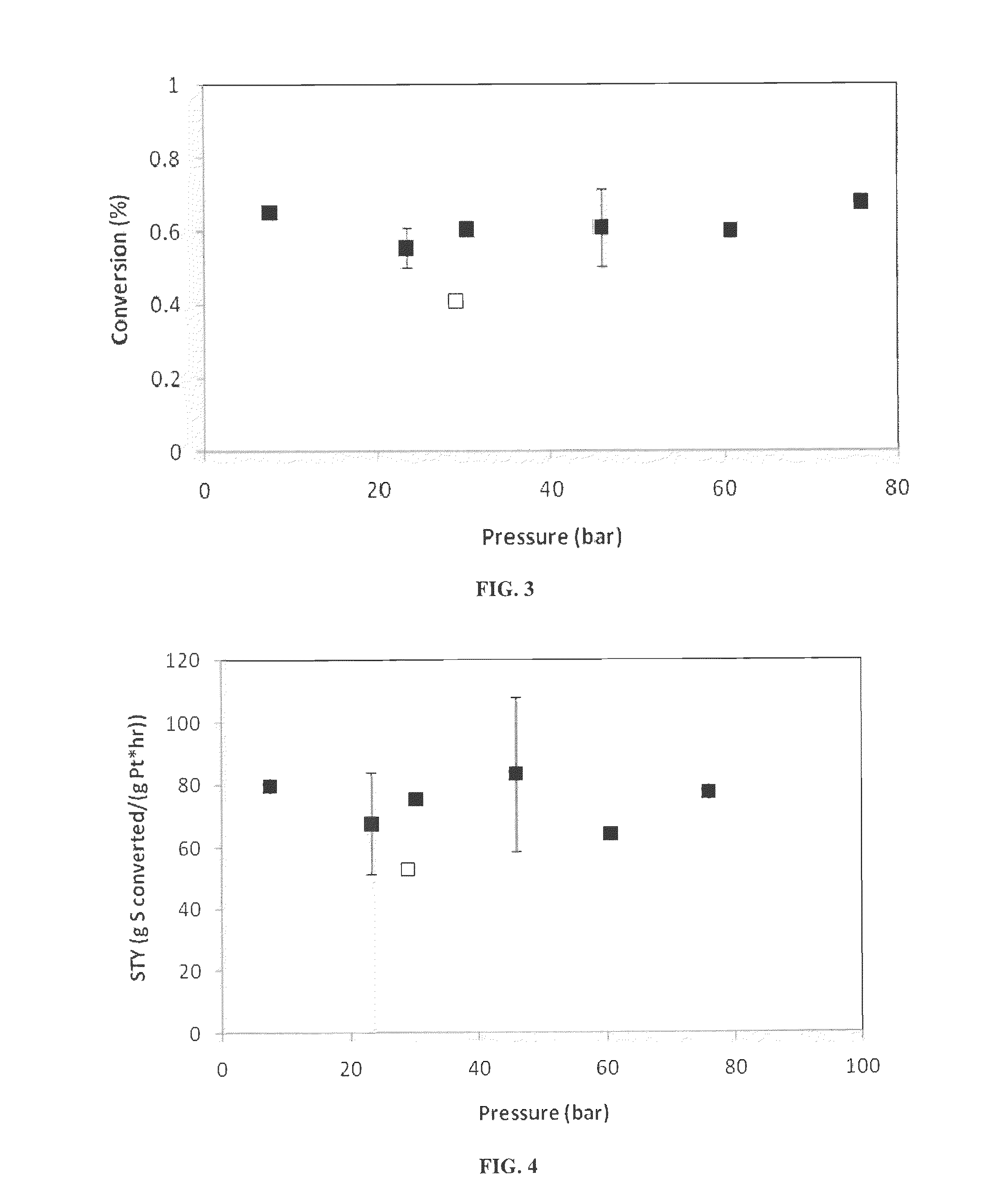Deoxygenation of Bio-Oils and Other Compounds to Hydrocarbons in Supercritical Media
a technology of biooil and other compounds, applied in the direction of biofeedstock, chemistry apparatus and processes, organic chemistry, etc., can solve the problems of high hydrogen partial requirement and exacerbating this limitation, and achieve the effect of increasing the selectivity of alkanes having n carbons and increasing the pressure of the reaction mixtur
- Summary
- Abstract
- Description
- Claims
- Application Information
AI Technical Summary
Benefits of technology
Problems solved by technology
Method used
Image
Examples
example 1
[0034]In this example, n-hexane, n-hexadecane (99%), nonanal (95%), nonanol (97%), nonanc (99%), and octane (97%) were purchased from Fisher Scientific and used as received. Platinum on alumina pellets (1 wt %, 3.2 mm pellets) were purchased from Sigma-Aldrich. Hydrogen gas (industrial grade) was purchased from Airgas and used as received.
[0035]The catalytic deoxygenation reactions were performed in a continuous fixed-bed reactor (see FIG. 2) at 300° C. over supported Pt / Al2O3 catalysts. Specifically, the deoxygenation of nonanal is presented using supercritical n-hexane as the solvent. A solution of 0.3 mol / L nonanal in n-hexane was fed to the reactor using a Thermo Separation Products Constametric 3200 pump. Hydrogen was fed through a solenoid valve and metered into the reactor using a Brooks Model 5850E mass flow controller. The liquid was preheated to 250° C. prior to mixing with H2 in an in-line mixer (Thar Designs). The reactor was heated by cartridge h...
example 2
Modeling
[0049]A simple mathematical model was developed to better understand the underlying physicochemical processes of Example 1. The model is based on an integral packed bed reactor mole balance assuming that the reaction is isothermal and that the lumped overall nonanal conversion rate is pseudo-first order in nonanal concentration. This assumption is valid given the 57:1 molar ratio of H2:nonanal in the feed and the fact that the H2 concentration did not significantly decrease in the product stream. The resulting model equation is shown in Equation 1:
keff=-ρcatυWln(1-xc9)(1)
Where keff=effective rate constant, min−1; ρcat=catalyst packing density, g / mL; v=total volumetric flow rate at reaction temperature and pressure, mL / min; W=mass of catalyst, g; xC9=nonanal conversion, dimensionless.
[0050]Based on the steady state nonanal conversion, effective rate constant values were estimated using equation 1. As shown in FIG. 6, the effective rate constant decreases exponentially with pr...
example 3
Catalyst Characterization
[0057]The BET surface area analyses of the fresh and spent Pt / Al2O3 catalysts are presented in FIG. 11. The surface area for fresh catalyst is 109.79 m2 / g, and pretreating at 300° C. with 100 sccm H2 reduces this surface area to 100.35 m2 / g. Following reaction, the surface area for the spent catalysts is relatively constant at approximately 80 m2 / g (±5%) for all reaction pressures examined. This trend holds true also when n-hexadecane is used as a solvent. These data suggest that the reaction conditions under study result in limited catalyst surface area loss, corroborating the steady conversions and selectivity corresponding to the various runs. These results also validate the assumption of constant catalyst activity when modeling the steady state conversion data.
PUM
 Login to View More
Login to View More Abstract
Description
Claims
Application Information
 Login to View More
Login to View More - R&D
- Intellectual Property
- Life Sciences
- Materials
- Tech Scout
- Unparalleled Data Quality
- Higher Quality Content
- 60% Fewer Hallucinations
Browse by: Latest US Patents, China's latest patents, Technical Efficacy Thesaurus, Application Domain, Technology Topic, Popular Technical Reports.
© 2025 PatSnap. All rights reserved.Legal|Privacy policy|Modern Slavery Act Transparency Statement|Sitemap|About US| Contact US: help@patsnap.com



